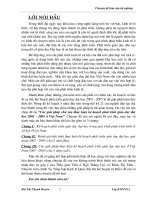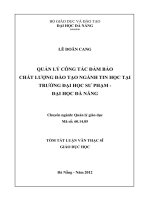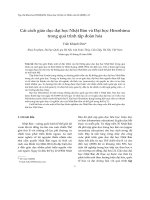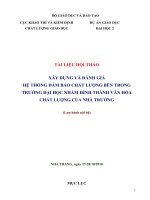Các vấn đề và xu thế đảm bảo chất lượng và giáo dục đại học tiếng anh
Bạn đang xem bản rút gọn của tài liệu. Xem và tải ngay bản đầy đủ của tài liệu tại đây (773.7 KB, 39 trang )
ISSUES AND TRENDS IN
QUALITY ASSURANCE AND
HIGHER EDUCATION-Planning in a Global Context
John N. Hawkins
Co-Director APHERP EWC-UCLA
US & UC System
Vietnam Presentation
BACKGROUND
QA can bring out both enthusiasm & cynicism
“Internal-External” shifts
b/w HE & host society
Private, inner world of HE & social context
Often stimulated by forces outside HE
Many terms: QA, evaluation, review, audit,
monitoring, QM, TQM, etc.
Conceptual Considerations
Context: international, national,
institutional, basic units
Methods--a General Model?
National coordinating body
Institutional self-evaluation
External peer review
Published reports
Policy, action follow-up
Conceptual Considerations
Impact of QA: system, institution, program,
department (basic units), individual
Values & QA: challenges existing values:
academic, managerial, pedagogic, expected
outcomes
Politics of QA: distribution of power,
decisions, transform HE, institutional
autonomy
The Rise of QA
Rise of “evaluative State” (Neave)
In context of “romantic view of HE” Kerr
Expansion of HE
Diversification of HE
Changing relations b/w HE & State
Bottom-up=incremental change
External State involvement=“fundamental change”
(Clark)
Emergence of National QA
Accreditation in US long-standing
QA in Europe, Asia, LA more recent
Diversity in QA approaches
Licensing by States (US & India)
important
Some argue (Trow) QA has done
nothing to improve HE
Diverse Purposes of QA
Accountability of public funds
Improve quality of HE provision
Inform funding decisions
Inform students & employers
Stimulate competitiveness b/w HEIs
QC of new privates
Assign status and rankings
Others?
Mechanisms of QA
Rewards: links to funding (yes or no?); formal
status allocation (accreditation); income;
influence; intangible
Changing policies & structures: everyday life
of HEI; fundamental change (PSRI at UCLA;
ELP), DC, corporatization, RCM
External affects Internal
Changing cultures (demise of “happy
anarchy”
Others: changing boundaries, factor favor
QA & Institutional Change
QA is everywhere
Massification+diversity=information
demand
QA used for branding purposes
State uses it for control
Funding is increasingly conditional
Shift on “control-autonomy” continuum
toward control
QA & Institutional Change
HEI no longer immune from QA:
professorial dilemmas
QM is one result: make sure these
ideas permeate the organization; data
collection and storage; accountability
We now have an “evaluative culture” for
better or worse
The UC Master Plan
A System Within a Non-System
Case: UC Master Plan for
Higher Education
At the time (1960) considered utopian
Access for all who desire Higher
Education
Criticized from both left (produce
overeducated and underemployed); and
right (HE should be elitist)
What is the Master Plan
A statewide policy and planning
framework first implemented in 1960 to
accommodate enrollment growth and
meet state human resource needs by
providing high-quality postsecondary
institutions.
History: California in late
1950’s
Constraints on state resources
End of postwar surpluses
Tax increase rejected by Legislature
Huge enrollment growth projected
Lack of coordination/planning
22 competing legislative proposals to
establish new state colleges
Kerr Proposal
Prevent unnecessary program/degree
duplication to limit taxpayer expenses
Offer access to all qualified residents
who could benefit from postsecondary
education
Legislature imposed a moratorium on
new campuses until plan completed
Primary Features of the MP
Differentiation of Mission and Functions
To ensure quality and efficient allocation of
resources
Limits the no. of campuses offering highcost doctoral and professional education
programs
Greater focus on undergraduate education
at the CSU and CCS
Cost structure enables universal access
University of California,
System
Office of the President, UC
Chancellor’s Office, California State
University
University of California: 10 research campuses-Chancellors
23 undergraduate, limited graduate campuses,
Presidents
Chancellor’s Office, California Community
Colleges
109 campuses--Chancellors, Presidents
University of California, Ten Campuses
Differentiation of Function: UC
State’s primary academic agency for research
Undergraduate, graduate, & professional education
Sole authority for doctoral degrees (CSU able to offer
joint doctorates)
Sole authority for instruction in law, medicine,
dentistry, and veterinary medicine
12.5% of top high school students
Differentiation of Function:
CSU
Undergraduate education, graduate and professional education
through MA
Primary responsibility for 69% of teacher education
Faculty research consistent with the primary mission of
instruction
Doctorates jointly with UC or an independent institution
33% of top high school students after the 12.5% is accepted to
UC
California Community College System 109 Campuse
Differentiation of Function:
Community Colleges
Open to all: 2 year program
Academic & vocational instruction through first two
years of undergraduate
Remedial instruction
English as Second Language courses
Adult noncredit instruction
Workforce training services
Transfers to UC and CSU
Values of Master Plan I
Principle of access
Differential admissions pool
To all who can benefit
State’s responsibility to fund access
To ensure high standards and to encourage less competitive
students to take lower division at the CCs--prove themselves
Community College transfer
Ensures universal access to 4 year institutions









